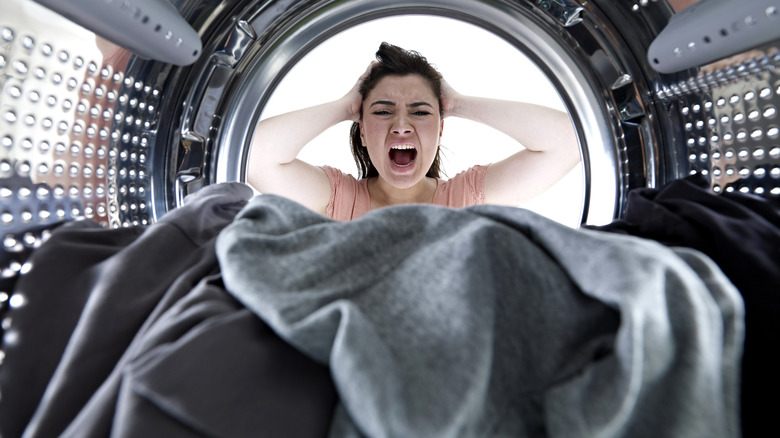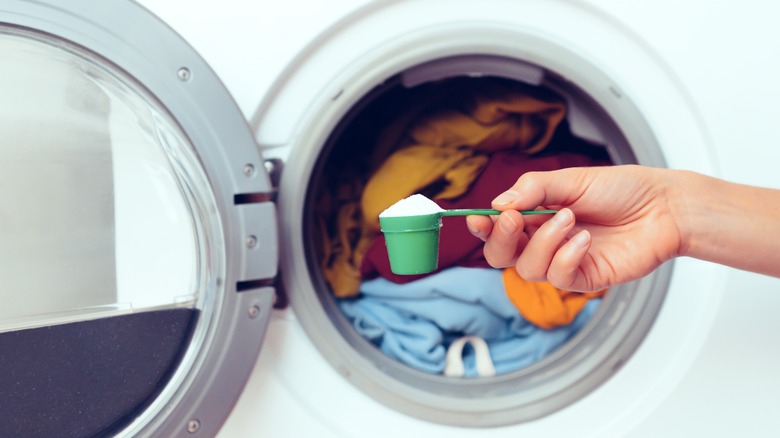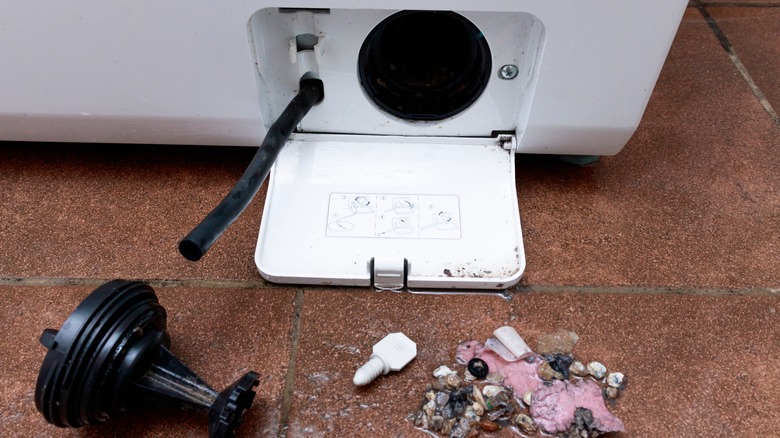Why You Have White Residue On Your Clothes After Washing (And How To Stop It)
"Why?!" The word escapes from the deepest bowels of your soul more like a pained exclamation than an innocent question immediately after opening your washing machine and finding your clean clothes littered with white residue. Next comes the stream of consciousness: Did you accidentally forget to remove tissue from your pockets? Is the washer broken? Should you have switched to liquidless laundry detergent sheets? Relax. In most cases, white residue on clothes after washing is simply the result of too much detergent and not enough water. Moreover, preventing it from recurring typically requires little more than selecting the right detergent and checking your washing machine before starting the load.
No question, discovering white residue on what should be clean laundry is frustrating on multiple levels. Not only does the fix require spending additional time rewashing, it also means you'll be paying extra money to run the load again. Unfortunately, doing so is inevitable when you find your laundry marred with white streaks, flakes, or specks. This residue is easy to spot, especially on dark-colored items; however, if your load primarily consists of white or light-colored pieces, there's a chance you may overlook the sediment — particularly if you're in a hurry or operating on autopilot. Regrettably, absent-mindedly tossing residue-marked clothes into the dryer will only exacerbate your problems as the heat will bake in the detergent, leading to crusty, abrasive clothes that are too uncomfortable to wear.
Causes of white residue on clean laundry
The most common cause of white residue appearing on freshly washed clothes involves laundry detergent. Using too much in a load is a recipe for disaster, especially if the water isn't warm enough to dissolve the soap. Be exceptionally mindful if you use powdered detergent as the dry granules need copious amounts of hot water and time to break down completely. If it lacks either, the undissolved detergent will settle on your laundry. The same is true if you add too much fabric softener.
However, if you notice your clothes are coated with white streaks even if you're using the recommended amount of soap or softener, the problem then may be too little water and too much laundry. Stuffing your washer with dirty clothes like a clown car prevents proper water circulation and drainage. Any leftover soap that isn't removed in the rinse cycle will appear as residue on your laundry.
If user error isn't the issue, though, inspect your washing machine. White residue could simply be caused by a dirty washer. Over time, dirt, soap scum, and mineral deposits can build up in the drum and adhere to your laundry during the wash cycle. If your drum is clean, the problem could be a clogged water pump. If a button, coin, or wad of lint is blocking your washing machine's water pump, water won't be able to drain out of the tub quickly enough, leaving your clothes covered with residue.
How to get rid of white residue on clean clothes
In most cases, eliminating a white-residue problem is an easy laundry fix. If you're committed to using powder detergent, simply decrease the amount and increase the temperature of the water so the soap fully dissolves. Likewise, liquid detergent should be used in moderation. Follow the suggested amounts printed on the container and refer to your washer's manual to determine whether or not you should be using high-efficacy (HE) detergent. HE washers use significantly less water than standard washers; consequently, you shouldn't add more than 2 teaspoons of liquid HE detergent per load. Additionally, never overstuff your washing machine, no matter how pressed you are for time. Instead, employ a simple trick to avoid overloading your washer that involves sticking your hand into the tub to determine available space.
If your machine is to blame for the white residue, however, start by giving it a good cleaning. Standard top-loading machines can be sanitized by adding 1 quart of bleach to a tub of hot water. Run the machine through the wash cycle, then repeat with 1 quart of distilled white vinegar. For front-loading machines, completely fill the bleach dispenser with chlorine bleach and add 1/2 cup to the detergent compartment before running a normal cycle. Next, consider cleaning the machine's drain line filter. Remove any lint or debris that may obstruct water flow. If you notice the washer is still draining slowly after cleaning, it may be time to call a professional.


